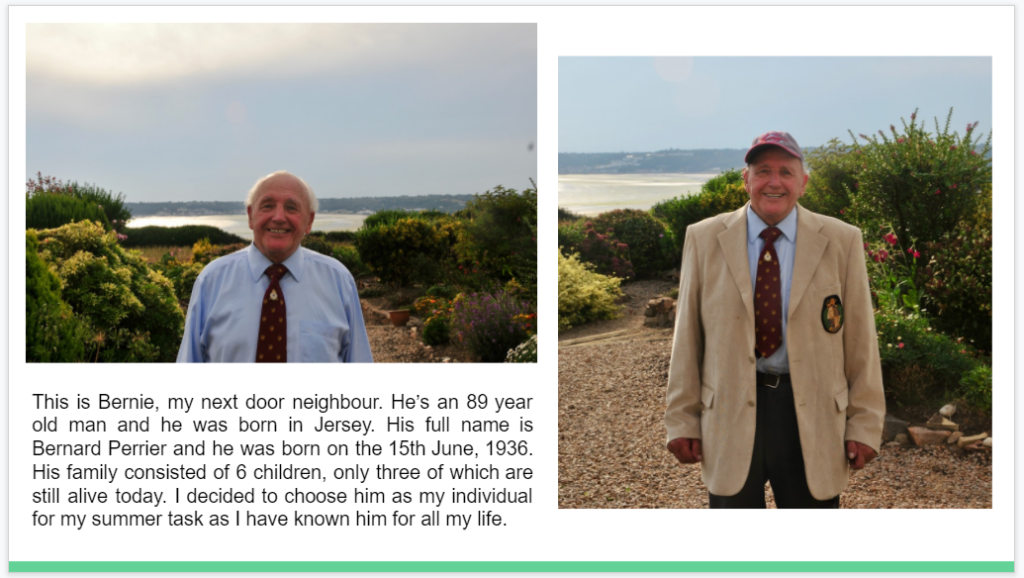
2 point lighting / high key
Two point lighting is the most versatile lighting design for shooting fashion or beauty on the street. Having a back light elevates the pictures to a more polished state. Take a look at any CSI tv show or 24 etc and freeze frame as you go. You will see two point lighting on just about every scene if not every shot.

WEEK 1 – What is Photography
- audit summer task/presentations and discuss
- intro… expectations / blog / outline of year
- what is photography – discuss & group work
Welcome to the course!
During your first lessons you will be expected to submit and display your summer task and informally present it to your group. As a group we will discuss the merits and limitations of your work and it will be assessed soon and you will receive feedback too.
(If you have not completed a Summer Task as a new recruit…then you have until Monday 13th September to complete the task appropriately.)
We will also discuss your thoughts and feelings / knowledge and understanding of…
Photography’s function(s)
Photography as an art-form
Photography as a science
The difference between the study of photography and the practice of photography
Henri Cartier-Bresson once said…”Your first 10,000 photographs are your worst”
What do you think Cartier-Bresson meant by this…? Discuss
Demonstrating a critical and contextual understanding of photography can be tricky, especially if the subject is relatively new to you in Year 12. The following activities have been designed to encourage you to reflect on what you know already about photography. Hopefully, some of the prompts will encourage you to further develop your understanding of photography through additional pondering and research.
In small groups, discuss the following questions. One person in the group should be responsible for making notes capturing the main ideas of the discussion:
- Why do people take/make photographs?
- Why is photography important?
- What skills do you need to be a good photographer?
- How many different kinds of photography can you think of?
- How does photography help us see the world?
- Can photographic images be trusted?
- What are the similarities and differences between photography and other types of visual art?
- When would it not be OK to take a photograph?
- How do you know when you’ve made a good photograph?
- Are photographers also artists?
- Where is the best place to see photographs?
- What kind of photography interests you most?
- What confuses or frustrates you about photography?
Watch this short film in which the photographer Henry Wessel discusses his practice. Make some brief notes. What does he help us to understand about photography?
Now compare with this example…
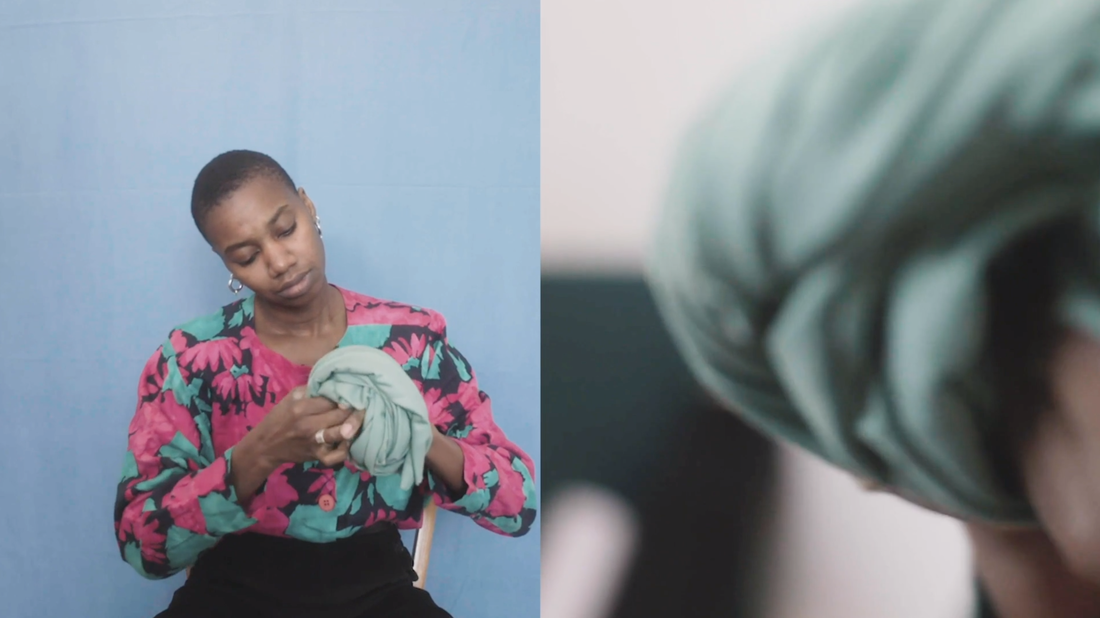
https://photoworks.org.uk/watch-artist-film-with-silvia-rosi/
Keep hold of your notes or capture them on your phone as you will be creating a blog over the next couple of weeks using your findings and thoughts.
history of photography
WHEN WAS PHOTOGRAPHY INVENTED?
The roots of photography extend back further than you might assume. In the 4th Century BC, Aristotle made use of the principles of the camera obscura, in which an image is projected through a small hole. Through a camera obscura’s pinhole, the image of the world is often reversed or upside-down. While our notion of a camera has evolved dramatically, the “camera obscura” is considered the ancient building block upon which further revolutionary developments and inventions in the field of photography were built.
WHO INVENTED PHOTOGRAPHY?
Joseph Nicéphore Niépce and Louis Daguerre are often considered the inventors of photography with cameras as we now know it. The former started out experimenting with silver chloride and silver halide photography, but couldn’t figure out how to prevent them from darkening with exposure to light.
In 1826, Niépce succeeded in taking the first camera photograph. He used a sheet of pewter coated with bitumen, which required an exposure time of at least 8 hours! The subject of this photograph hit close to home for Niépce; it is the view from his workroom in Saint-Loup-de-Varennes, France.
Painter Louis Jacques Mandé Daguerre was so excited by this achievement, he partnered with Niépce. Daguerre continued to develop, refine, and tinker with the process using silver-plated sheets of copper and fuming them with mercury vapor. As he continued to develop this process, Daguerre was able to vastly reduce to the exposure time.
After their invention, it took a long time for photographs and cameras to develop into what we have come to know today. This required more revolutionary ideas and exciting reinventions, which we can now look back on as milestones in the history of photography.
The film roll: In 1889, George Eastman created the roll of film, which made it possible to shoot multiple pictures one after the other. He released it through his company Kodak, and it was a breakthrough in the practical application of photography. It made snapshots possible, and no longer did the images need to be immediately and individually processed. In the same year, Thomas Edison cut it down the middle and added perforated edges, establishing the 35mm format that became so prevalent later.
The 35mm camera: The first Leica camera was developed by Oskar Barnack. Introduced in 1925, the Leica prototype used a small-format, 35mm film. In comparison to the bulky box cameras previously in use, the compact Leica camera was a highly modern improvement.
Color photos: In 1936, photographic technology took an exciting step forward with advances in color film. Kodak released Kodachrome, a film with multiple layers for developing in color.
Polaroid Pictures: Around that time, the first instant camera was also invented. The aesthetic is as popular as ever, enthusiastically coopted by photo services such as Instagram. The Polaroid camera introduced by Edwin H. Land in 1848 was capable of producing a fully developed photo shortly after taking it.
The Digital Camera: While the concept of digital cameras has existed since the 1960s, the camera Steven Sasson of Eastman Kodak built in 1975 is generally considered the first self-contained digital camera. Much like photography with film, advances in the technology have led to explosive growth in the medium’s popularity.
ESSAY WRITING
Objective: Criteria from the Syllabus
- Be aware of some of the methods employed by critics and historians within the history of art and photography.
- Demonstrate a sound understanding of your chosen area of study with appropriate use of critical vocabulary. – use for image analysis
- Investigate a wide range of work and sources
- Develop a personal and critical inquiry.

Academic Sources:
- Research and identify 3-5 literary sources from a variety of media such as books, journal/magazines, internet, Youtube/video .
- Begin to read essay, texts and interviews with your chosen artists as well as commentary from critics, historians and others.
- It’s important that you show evidence of reading and draw upon different pints of view – not only your own.
- Take notes when you’re reading…key words, concepts, passages
- Write down page number, author, year, title, publisher, place of publication so you can list source in a bibliography
Quotation and Referencing:
Why should you reference?
- To add academic support for your work
- To support or disprove your argument
- To show evidence of reading
- To help readers locate your sources
- To show respect for other people’s work
- To avoid plagiarism
- To achieve higher marks
What should you reference?
- Anything that is based on a piece of information or idea that is not entirely your own.
- That includes, direct quotes, paraphrasing or summarising of an idea, theory or concept, definitions, images, tables, graphs, maps or anything else obtained from a source
How should you reference?
Use Harvard System of Referencing…see Powerpoint: harvard system of referencing for further details on how to use it.https://player.vimeo.com/video/223710862?dnt=1&app_id=122963
Here is an full guide on how to use Harvard System of Referencing including online sources, such as websites etc.
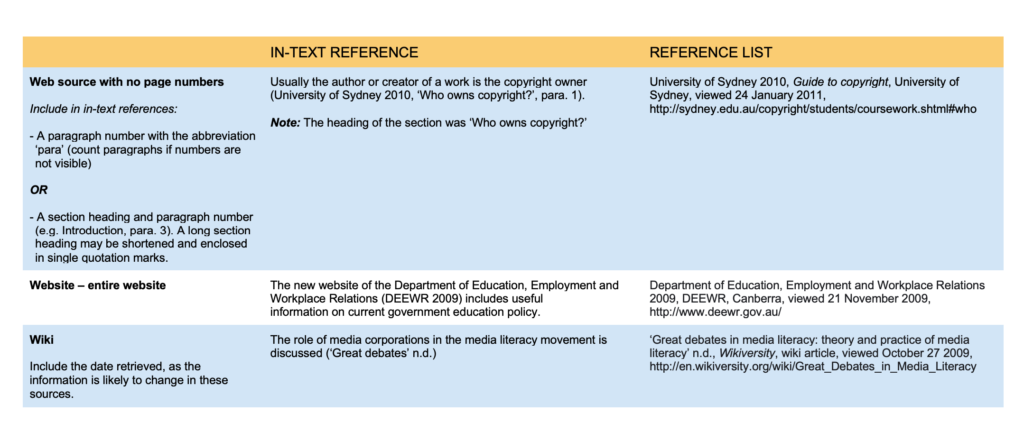
TUE: Essay Question
- Think of a hypothesis and list possible essay questions
- Below is a list of possible essay questions that may help you to formulate your own.
possible-questions-to-investigate-1DOWNLOAD
Some examples of Personal Study essays from previous students
To what extent can we trust documentary photography to tell the truth about reality?
How does Jeff Wal’s Tableaux approach depict a seemingly photojournalistic approach?
Compare how Cindy Sherman and Phoebe Jane Barrett challenge gender stereotypes.
How can something that doesn’t physically exist be represented through photography?
How does the work of Darren Harvey-Regan explore abstraction as an intention and process?
Essay Plan:
Make a plan that lists what you are going to write about in each paragraph – essay structure.
- Essay question:
- Opening quote
- Introduction (250-500 words): What is your area study? Which artists will you be analysing and why? How will you be responding to their work and essay question?
- Pg 1 (500 words): Historical/ theoretical context within art, photography, visual and popular culture relevant to your area of study. Make links to art movements/ isms and some of the methods employed by critics and historian.
- Pg 2 (500 words): Analyse first artist/photographer in relation to your essay question. Present and evaluate your own images and responses.
- Pg 3 (500 words): Analyse second artist/photographer in relation to your essay question. Present and evaluate your own images and responses.
- Conclusion (250-500 words): Draw parallels, explore differences/ similarities between artists/photographers and that of your own work that you have produced
- Bibliography: List all relevant sources used
Essay question: Hypothesis
Think of a hypothesis and list possible essay questions
Here is a list of possible questions to investigate that may help you.
Opening quote: Choose a quote from either one of your photographers or critics. It has to be something that relates to your investigation
ESSAY STRUCTURE
See below for a possible essay structure. Further help can be found here essay structure or see link here The Royal Literay Fund
Introduction (250-500 words). Think about an opening that will draw your reader in e.g. you can use an opening quote that sets the scene. You should include in your introduction an outline of your intention of your study e.g. what and who are you going to investigate. How does this area/ work interest you? What are you trying to prove/challenge, argument/ counter-argument? What historical or theoretical context is the work situated within. Include 1 or 2 quotes for or against. What links are there with your previous studies? What have you explored so far in your Coursework or what are you going to photograph? How did or will your work develop. What camera skills, techniques or digital processes in Photoshop have or are you going to experiment with?
Paragraph 1 Structure (500 words) : Use subheading. This paragraph covers the first thing you said in your introduction that you would address. The first sentence introduces the main idea of the paragraph. Other sentences develop the subject of the paragraph.
Content: you could look at the following…exemplify your hypothesis within a historical and theoretical context. Write about how your area of study and own work is linked to a specific art movement/ ism. Research and read key text and articles from critics, historians and artists associated with the movement/ism. Use quotes from sources to make a point, back it up with evidence or an example (a photograph), explain how the image supports the point made or how your interpretation of the work may disapprove. How does the photograph compare or contrast with others made by the same photographer, or to other images made in the same period or of the same genre by other artists. How does the photograph relate to visual representation in general, and in particularly to the history and theory of photography, arts and culture.
Include relevant examples, illustrations, details, quotations, and references showing evidence of reading, knowledge and understanding of history, theory and context!
See link to powerpoints: Pictorialism vs Realism and Modernism vs Postmodernism herepictorialism-vs-realism-2DOWNLOADmodernism-vs-postmodernism_v2-2DOWNLOAD
Paragraph 2 Structure (500 words) : Use subheading. In the first sentence or opening sentences, link the paragraph to the previous paragraph, then introduce the main idea of the new paragraph. Other sentences develop the paragraphs subject (use relevant examples, quotations, visuals to illustrate your analysis, thoughts etc)
Content: you could look at the following...Introduce your first photographer. Select key images, ideas or concepts and analyse in-depth using specific model of analysis (describe, interpret and evaluate) – refer to your hypothesis. Contextualise…what was going on in the world at the time; artistically, politically, socially, culturally. Other influences…artists, teachers, mentors etc. Personal situations or circumstances…describe key events in the artist’s life that may have influenced the work. Include examples of your own photographs, experiments or early responses and analyse, relate and link to the above. Set the scene for next paragraph.
Include relevant examples, illustrations, details, quotations, and references showing evidence of reading, knowledge and understanding of history, theory and context!
Paragraph 3 Structure (500 words) : Use subheading. In the first sentence or opening sentences, link the paragraph to the previous paragraph, then introduce the main idea of the new paragraph. Other sentences develop the paragraphs subject (use relevant examples, quotations, visuals to illustrate your analysis, thoughts etc)
Content: you could look at the following…Introduce key works, ideas or concepts from your second photographer and analyse in-depth – refer to your hypothesis…Use questions in Pg 2 or add…What information has been selected by the photographer and what do you find interesting in the photograph? What do we know about the photograph’s subject? Does the photograph have an emotional or physical impact? What did the photographer intend? How has the image been used? What are the links or connections to the other photographer in Pg 2? Include examples of your own photographs and experiments as your work develop in response to the above and analyse, compare, contrast etc. Set the scene for next paragraph.
Include relevant examples, illustrations, details, quotations, and references showing evidence of reading, knowledge and understanding of history, theory and context!
Conclusion (500 words) : Write a conclusion of your essay that also includes an evaluation of your final photographic responses and experiments.
List the key points from your investigation and analysis of the photographer(s) work – refer to your hypothesis. Can you prove or Disprove your theory – include final quote(s). Has anything been left unanswered? Do not make it a tribute! Do not introduce new material! Summarise what you have learned. How have you been influenced? Show how you have selected your final outcomes including an evaluation and how your work changed and developed alongside your investigation.
Bibliography: List all the sources that you used and only those that you have cited in your text. Where there are two or more works by one author in the same year distinguish them as 1988a, 1988b etc. Arrange literature in alphabetical order by author, or where no author is named, by the name of the museum or other organisation which produced the text. Apart from listing literature you must also list all other sources in alphabetical order e.g. websites, exhibitions, Youtube/TV/ Videos / DVD/ Music etc.
FORMAL ELEMENTS
| Photographs consist of formal and visual elements and have their own ‘grammar’. These formal and visual elements (such as line, shape, repetition, rhythm, balance etc.) are shared with other works of art. But photographs also have a specific grammar – flatness, frame, time, focus etc. ‘Mistakes’ in photography are often associated with (breaking) the ‘rules’ and expectations of this grammar e.g. out of focus, subject cropped, blur etc. Some photographers enjoy making beautiful images but others are more critical of what beauty means in today’s world.Photographers have to impose order, bring structure to what they photograph. It is inevitable. A photograph without structure is like a sentence without grammar—it is incomprehensible, even inconceivable. — Stephen Shore |
This way of thinking about photographs has come to seem a bit old fashioned due to competing theories of photographic meaning, Postmodernism and digital culture. It is certainly true that formalist readings of photographs alone can never do full justice to the complex webs of meaning generated by photographic images. Photographs aren’t neutral. They don’t show us things as they are, although they’re pretty good at pretending they do. Photographs are ideological constructs, a fancy way of saying that they don’t simply show us what is ‘true’ or ‘real’.
However, one might argue that photo literacy in part depends on an understanding of the formal or visual elements, some of which are borrowed from the visual arts, with others appearing to be specific to photography. As in any language, ‘grammar’ gets you so far, helps you appreciate the structure and ‘rules’ governing particular modes of expression. A knowledge of the ‘grammar’ of photography is therefore part of the analytical and creative toolkit of any photography student.
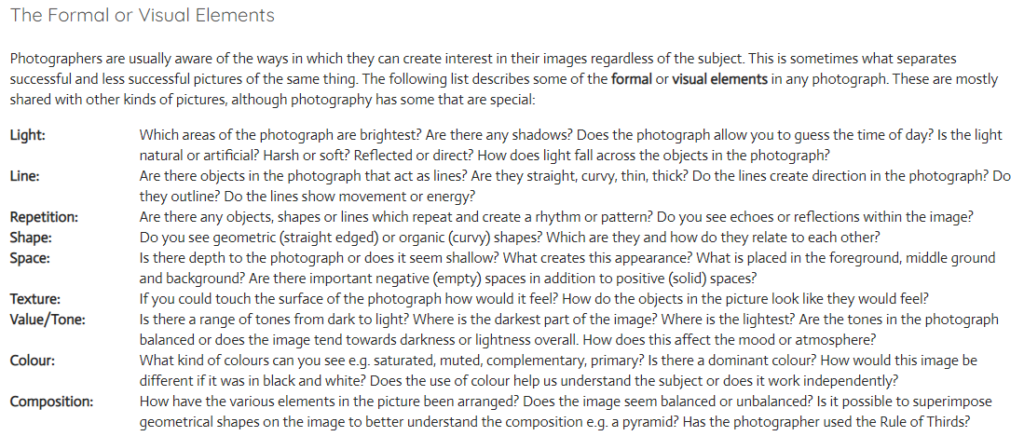
The photograph below is by Paul Strand. It is entitled ‘Abstraction, Twin Lakes, Connecticut’ and was made in 1916. You can read more about the image here. The photographer created a picture that draws attention to the Formal Elements. Spending some time really exploring photographs in terms of the formal elements is an important process in the development of visual literacy.
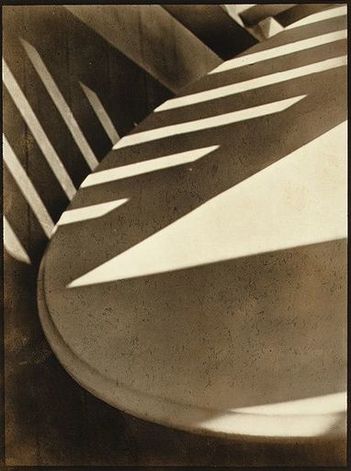
Light: A triangular slash of bright sunlight appears in the middle of the image. This is accompanied by bands of light running diagonally across the upper portion of the image. These appear to be gaps in another object out of shot, a fence perhaps. Line & Shape: There are number of strong lines, mostly straight, although these are complemented by the sweeping curve of the main object which runs from the top right of the image to the bottom right. All of the lines have the geometric quality of man made objects. Repetition: The shafts of sunlight running across two surfaces create a dramatic rhythm. A number of straight parallel lines punctuate the composition, like repeated notes or beats in a piece of music. Space: The space in the image appears quite shallow, tightly constrained by the framing. We don’t see the whole of any of the objects and the photographer appears to have been quite close to the subject. Texture: All of the objects in the image appear smooth. The drama comes from the jagged bursts of light across their surfaces. Value/Tone: The image contains a range of tones from very dark to very light. There are deep shadows but also mid tones. The photograph is monochrome but has a brownish tint, perhaps caused by the paper the artist has used. Composition: A sense of drama is created by the diagonal lines and the objects seeming to tilt towards the bottom left of the picture. |
Link to excellent BBC Resource / formal elements and more…

Analysing and Interpreting Robert Frank – Trolley, New Orleans


A guide to evaluating a Photograph: Key Themes, Content, Formal Elements, Process & Mood.
Key Themes – brief background information about the photographer or genre
Gain insight from title of image, date of image etc. Background research etc.
Content – Describe what you see! Look at the subject of the photograph.
What is it? What is it about? What is happening? What is in the foreground, midground, background? Where and when was it taken?
What do you think the relationship is between the photographer and the subject/s is? What has the photographer titled the image and why? Does the title change the way we see the image? Is it staged? Is it real?
Is it a realistic depiction? Has it been manipulated in anyway? If so, where and why? What is the theme of the photograph? What message does the photograph communicate?
Formal Elements – break the image down into the elements that make it up.
Colour, lighting, composition, structure, mood etc.
Colour – Is the photograph colour or black and white? Is there a reason for this? How does this affect the mood? What colours are depicted?
Lighting – is it photographed in a studio? Is it using studio lighting? Natural lighting? Has the photographer waited for the right natural light? Has the photographer positioned themselves? Vantage point. Is the lighting subtle? Is it strong? If so why and who has the lighting been used? Effectively or not? Does the lighting help the image? Why? Create mood/atmosphere? Dark, light?
Tone – Is the photograph high or low contrast? How and why? What tonal values.
Line/Composition – What sort of lines are there in the image? Leading lines? How have they been positioned in relation to the rest of the image? Is this on purpose? (the viewfinder or cropped afterwards?) What effect does this have?
Shape/Composition – What sort of shapes are there in the image? Do they remind you of anything? Do you think the photographer meant this? Is there symmetry? Is it structured in anyway? Rule of thirds? ‘S’ shape? ‘J’ shape. Golden Spiral, Golden Ratio, Fibonacci? Is it minimal? Simple? Complex? Confused?
Process – how the photograph has been taken, developed, manipulated and printed
Was the image taken inside or out? What time of day? Light sources? Evidence. Materials or tools used (props, objects, studio etc) Has the image been manipulation post production? How and why? B&W or colour? Plate, C print, large format, medium format, pin hole, slide, digital print, projection etc. Date may help.
Mood – look at the mood and feeling of the image
Is the photographer attempting to capture a moment/atmosphere/emotion? Explain why you think this. Is there a narrative/story? How does the image make you feel? Why do you feel like this? How and why?
USEFUL VOCABULARY
Colour
Intense Saturated Bright Luminous Secondary
Clash Mixed Soft Cold Opaque
Tint Deep Pale Translucent Dull
Pastel Transparent Glowing Primary Vibrant
Harmonious Pure Warm Dark
Tone
Dark Harsh Bright Fade Intense
Contrast Fair Smooth Crisp Gradation
Sombre
Composition
Background Distant Middle Ground Blurred
Shape Scale Perspective Confused
Foreground Space Form Proportion
Symmetry Structured
Light
Artificial Gentle Natural Dapple Harsh
Night Dark Haze Shading Highlight
Shadow Evening Intense Soft Light
Source Midday Tone Directional Bright
Focussed
Mood/Feeling
Alive Disturbing Sad Atmospheric Exciting
Humorous Delicate Expressive Depressing Happy
Energised Shocking Questioning Thought provoking
Powerful
ASSESSMENT CRITERIA



Follow the 10 Step Process and create multiple blog posts for each unit to ensure you tackle all Assessment Objectives thoroughly :
- Mood-board, definition and introduction (AO1)
- Mind-map of ideas (AO1)
- Artist References / Case Studies (must include image analysis) (AO1)
- Photo-shoot Action Plan (AO3)
- Multiple Photoshoots + contact sheets (AO3)
- Image Selection, sub selection, review and refine ideas (AO2)
- Image Editing/ manipulation / experimentation (AO2)
- Presentation of final outcomes (AO4)
- Compare and contrast your work to your artist reference(AO1)
- Evaluation and Critique (AO1+AO4)
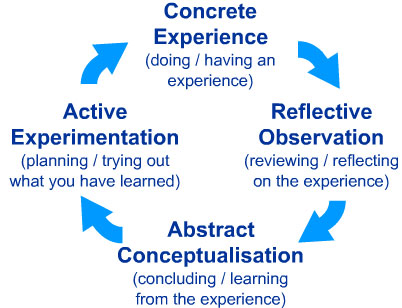
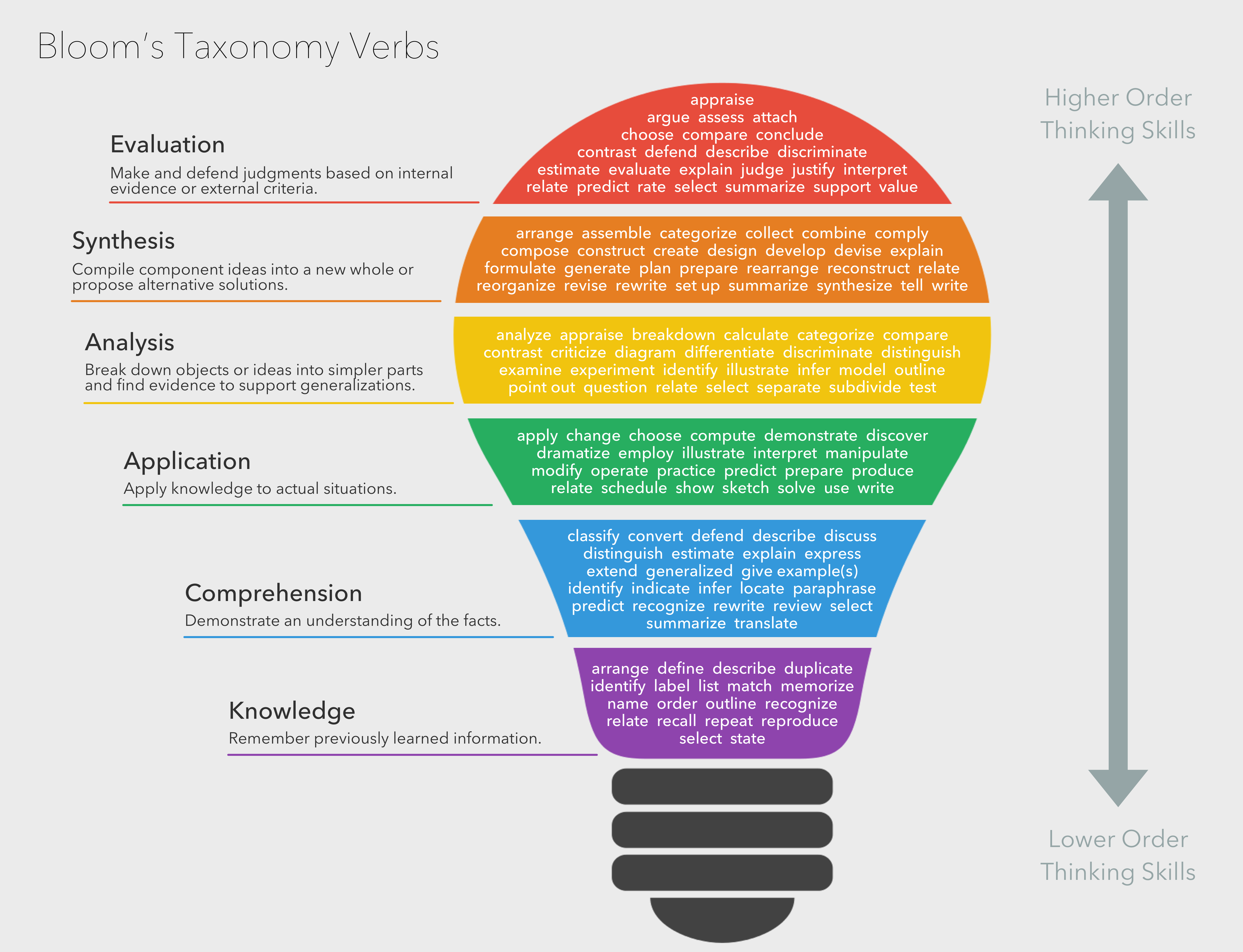
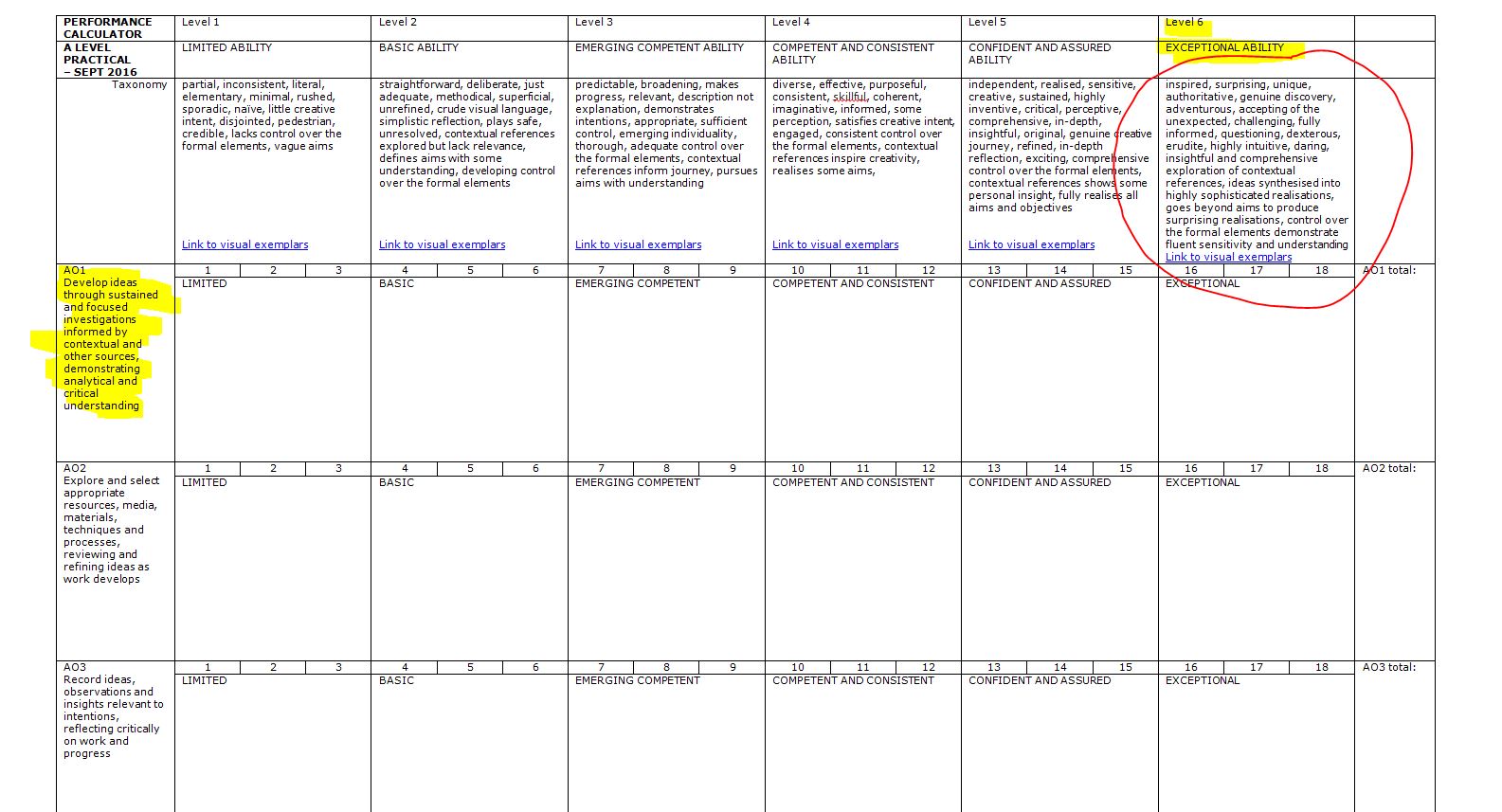

CAMERA HANDLING SKILLS

Please refer to this resource to help you navigate your camera’s function and settings. You will learn how to apply these skills learning to various photo-shoots over the next few months…and you should aim to provide evidence of these skills throughout your coursework.
Remember to practice and experiment. Use your eyes and look. The more you look, the more you will see. How you see the world will determine what kind of photographer you will become.
A camera is only a tool, and it is down to you to get the best out of your equipment by becoming confident and comfortable
Camera Skills
You must experiment with each of these skill areas as we move through our sequence of photo-shoots. Remember to include / produce a blog post on each that includes evidence of your experiments and successes…
Remember to use What / How / Why / When when describing and explaining what you are experiencing and achieving with each of these…
- Using Auto-Focus
- Using Manual Focus
- White Balance
- ISO
- Aperture
- Focal Length : wide, standard and telephoto lenses
- Depth of Field
- Show / fast Shutter Speed
- Exposure and exposure compensation
- Exposure bracketing
Ansel Adams and the visualisation of an image
Exposure Triangle : ISO – Shutter Speed- Aperture

Depth of Field
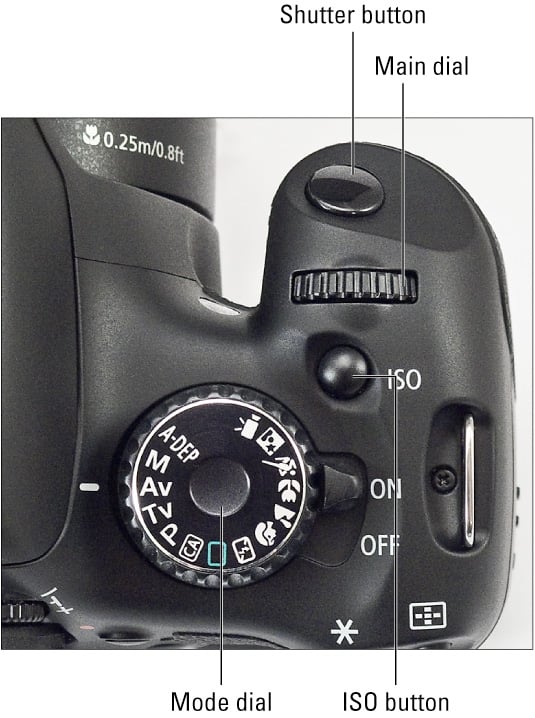
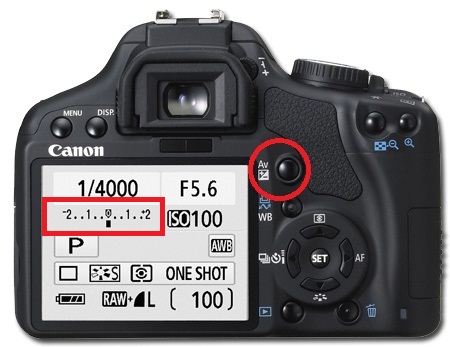

Exposure Bracketing
Many digital cameras include an Auto Exposure Bracketing (AEB) option. When AEB is selected, the camera automatically takes three or more shots, each at a different exposure. Auto Exposure Bracketing is very useful for capturing high contrast scenes for HDR like this…
…by taking the same photograph with a range of different exposure settings
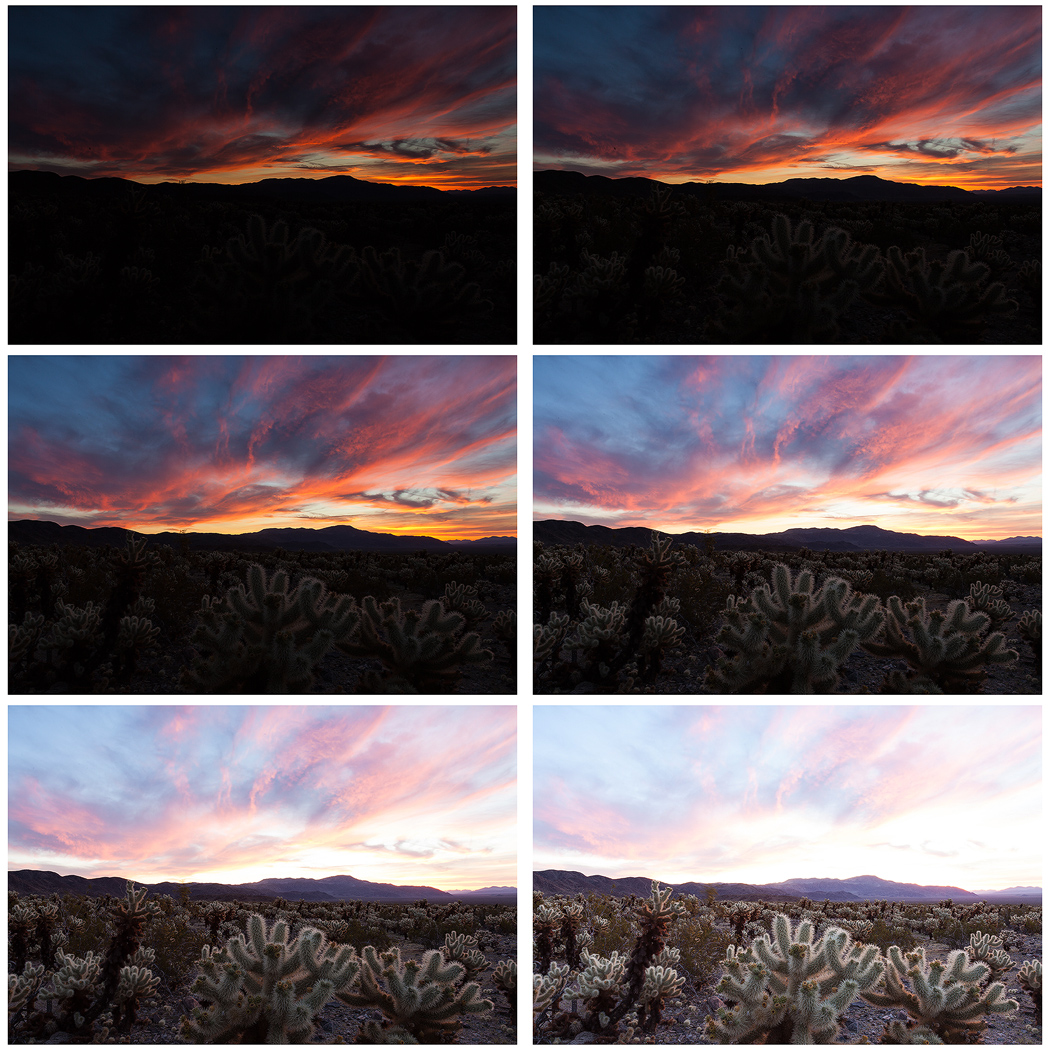
You can use Exposure Compensation to quickly adjust how light or how dark your exposure will be using these controls…

Or set the amount of “bracketing” like this…

Then you can create your High Dynamic Range images by using this process in Adobe Photoshop…

Understanding Composition
- The Rule of Thirds
- One of the fundamentals of painting and photography, the Rule of Thirds is a technique designed to help artists and photographers build drama and interest in a piece. The rule states that a piece should be divided into nine squares of equal size, with two horizontal lines intersecting two vertical lines.
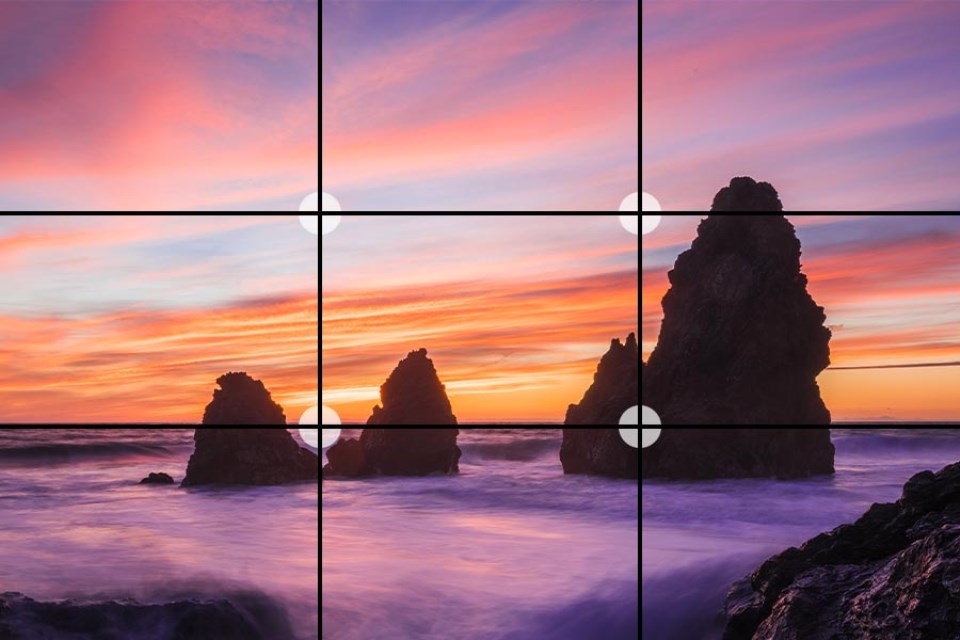
2. Fibonacci Curve
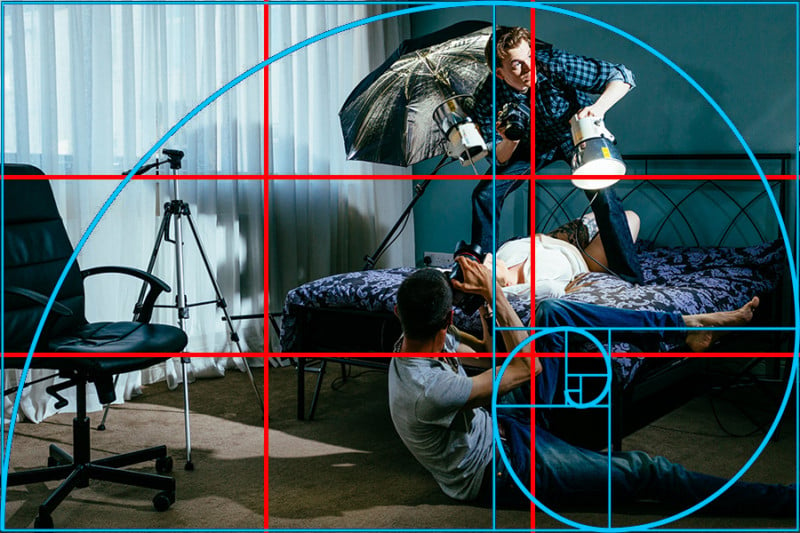
3. Triangles / angles / Golden Section
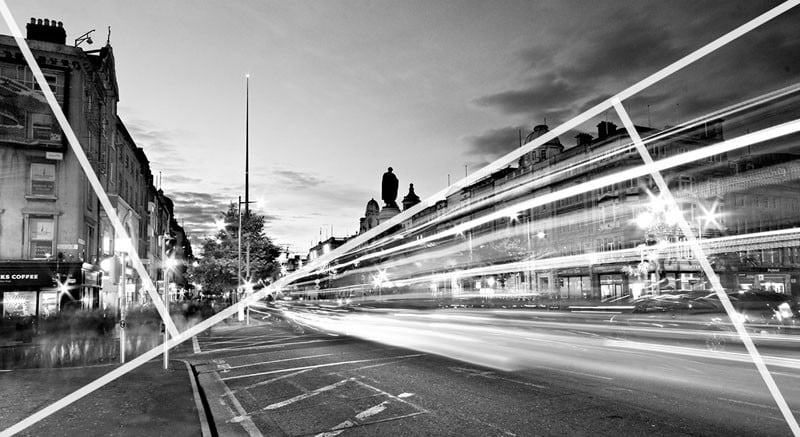
Cropping / framing

Understanding Lenses and Focal Length

Perspective and Depth
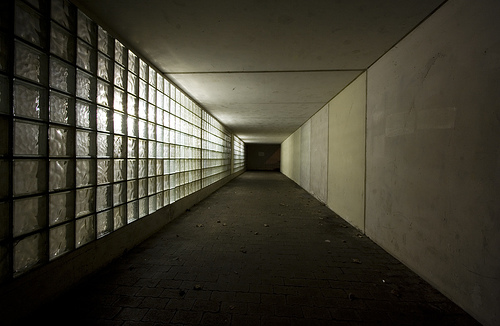


Photo Shoot Plan

Using the lighting studio
Once you have been instructed on how to use the lighting studio safely and respectfully, you will be able to use the studio during lesson times or in study periods. You must book the facility in advance via one of your teachers JAC / MM / MVT / CMK
You must always leave the studio in a clean and tidy, safe manner. All equipment must be switched off and packed away. Any damage must be reported and logged.
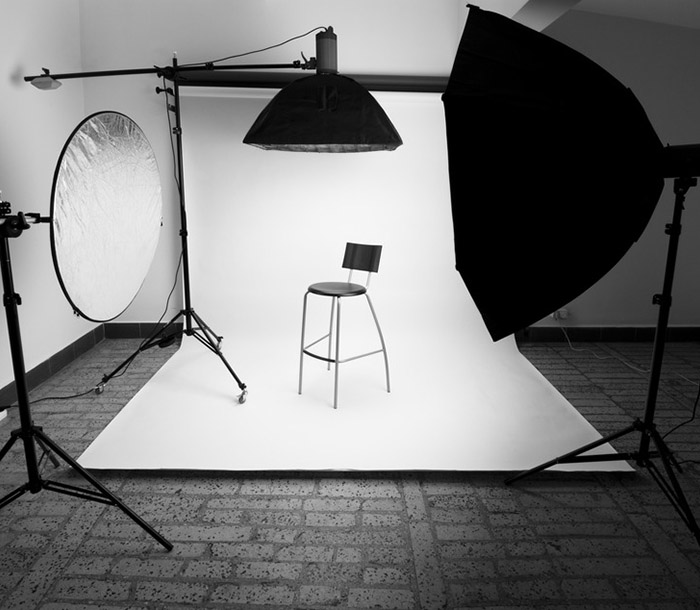
Types of lighting available
- Continous lighting (spot / flood)
- Flash head
- Soft box
- Reflectors and coloured gels


Still Life Photography and using the product table / copy stand

Still-life Studio Shoot:
You can choose to photograph each object individually or group together several objects for a more complex still life arrangements.
Technical stuff
Continuous Lights – photograph objects three dimensionally
Camera setting: Manual Mode
ISO: 100
White Balance: Daylight
Aperture: F/16
Shutter: 0.5 sec to 0.8 sec (depending on reflection of each object)
Lights in room must be switched off to avoid reflections
Continuous Lights – portrait
Camera setting: Manual Mode
ISO: 100
White Balance: Daylight Shutter Speed 1/125 sec Aperture f/16
Flash Lights – photograph images, documents, books, newspapers, etc or portraits
Camera setting: Manual Mode
ISO: 100
White Balance: Daylight
Aperture: F/16
Shutter: 1/125-1/200 (depending on reflection of each object)
Flash heads set to power output: 2.0
Use pilot light for focusing
PORTRAITS
Camera settings (flash lighting)
Tripod: optional
Use transmitter on hotshoe
White balance: daylight (5000K)
ISO: 100
Exposure: Manual 1/125 shutter-speed > f/16 aperture
– check settings before shooting
Focal lenght: 105mm portrait lens
Camera settings (continuous lighting)
Tripod: recommended to avoid camera shake
Manual exposure mode
White balance: tungsten light (3200K)
ISO: 400-1600 – depending on how many light sources
Exposure: Manual 1/60-1/125 shutter-speed > f/4-f/8 aperture
– check settings before shooting
Focal length: 50mm portrait lens
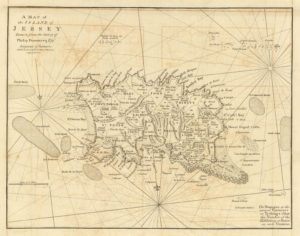
SUmmer TAsk for new students 2022
“MY JERSEY”
Your A Level Photography Summer Task is to respond to what Jersey means to you. You could explore aspects of heritage , lifestyle, community, surroundings, the past, present or future. You must complete a sequence of individual tasks and respond thoughtfully and creatively in order to produce a range of visual outcomes.
Expected time input = 5 hours minimum – 10 hours maximum
To get started you must choose at least one person who has a connection to Jersey. Take notes on their personal details (why and how they are in Jersey, name, age etc.) Then, you must agree with the person how you will photograph them (portraits), photograph a selection of personal objects and artefacts, and also photography a specific location. The three components must connect the person to the place.
From these images : You will be creating a set of simple photo-montages that are based on a combination of a person, an object and a place…
1. by stacking 3 images on top of each other in a strict order. This can be done digitally or created with prints, scissors, glue etc…
2. by juxtaposing 2 / 3 images alongside each other
3. by merging or blending 3 images together to create a double or multi-exposure
Stacking
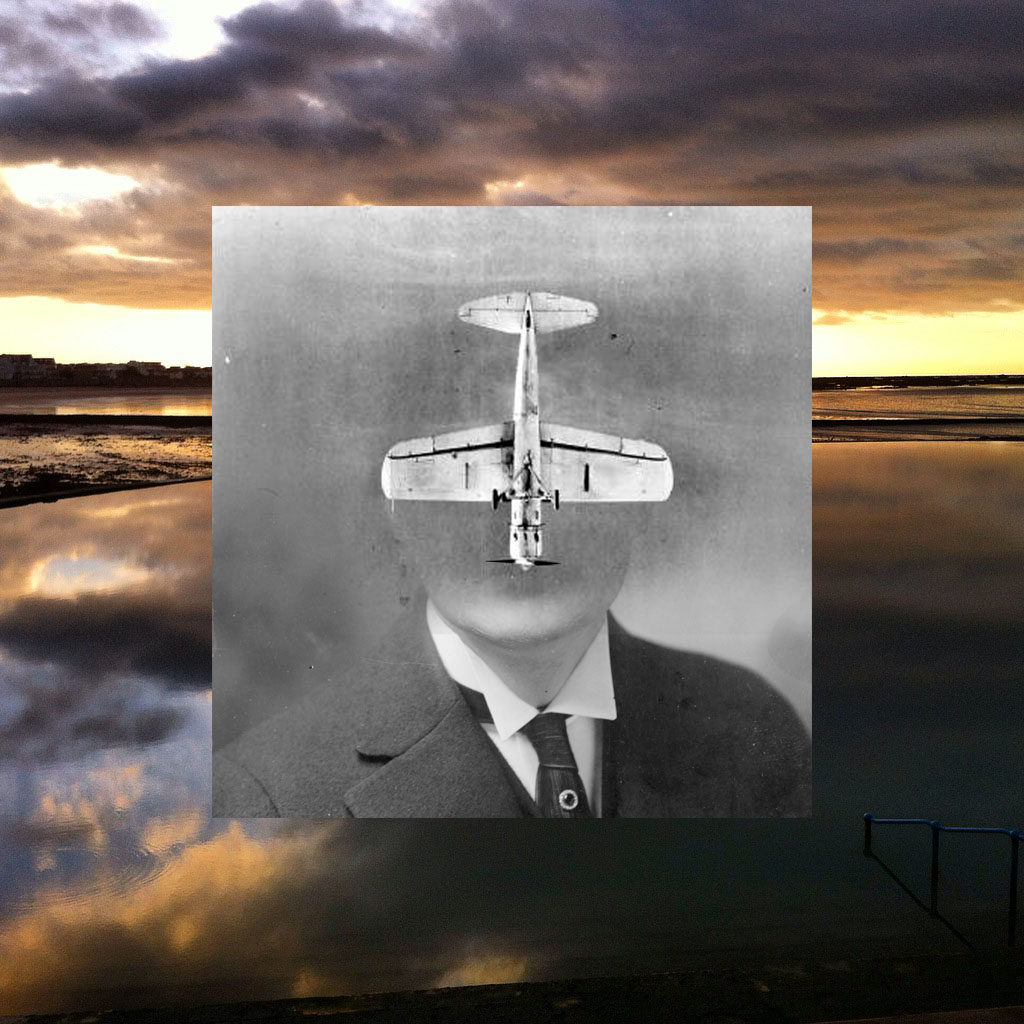
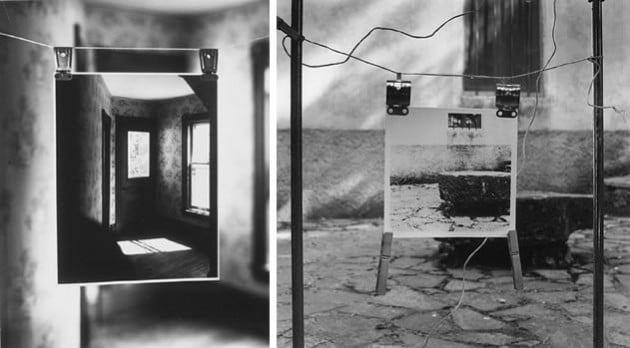
Juxtapose
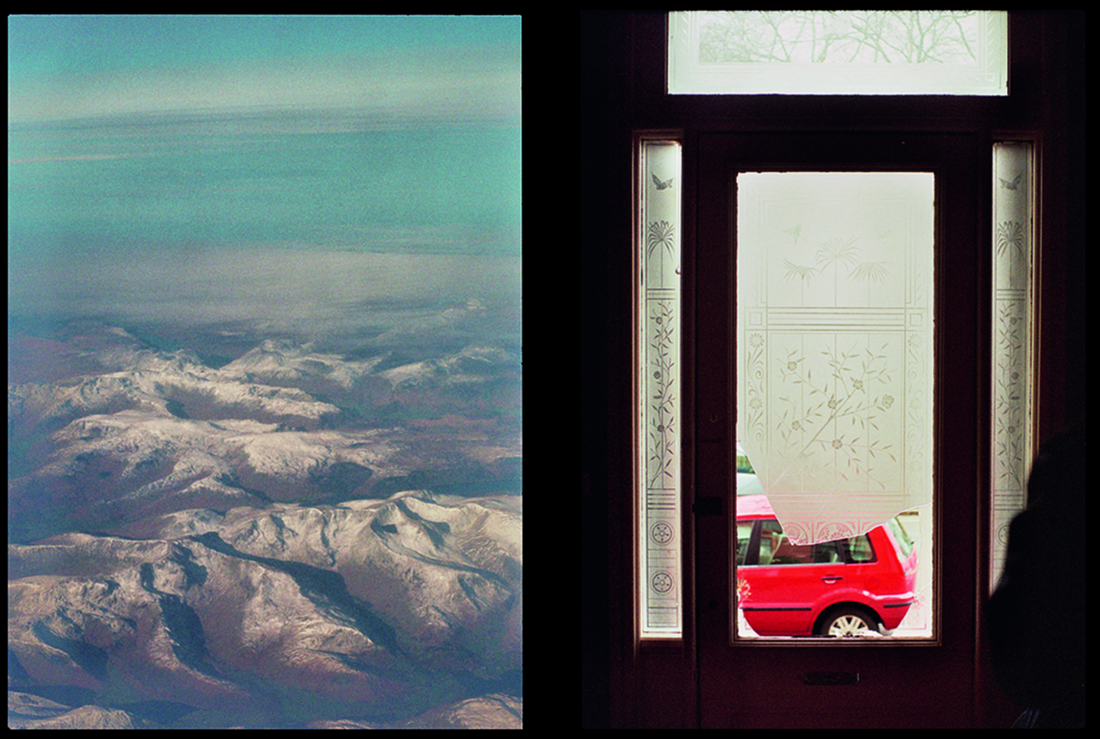

Merge
DOUBLE / MULTI-EXPOSURES
Double or multiple exposures are an illusion created by layering images (or portions of images) over the top of each other. This can be achieved in the camera settings, or on Adobe Photoshop by creating LAYERS and then using BLENDING OPTIONS and OPACITY CONTROL. Artist have used these techniques to explore Surrealist Ideas and evoke dream-like imagery, or imagery that explores time / time lapse.
You could use apps like BLENDEDITOR for this…on your iphone
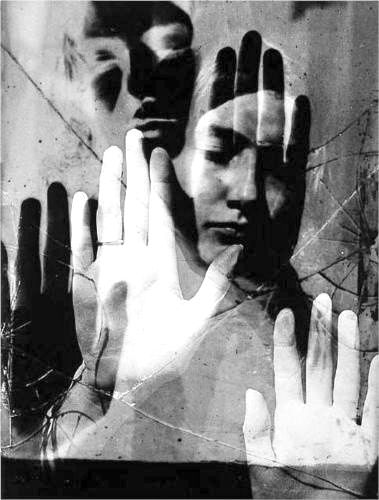
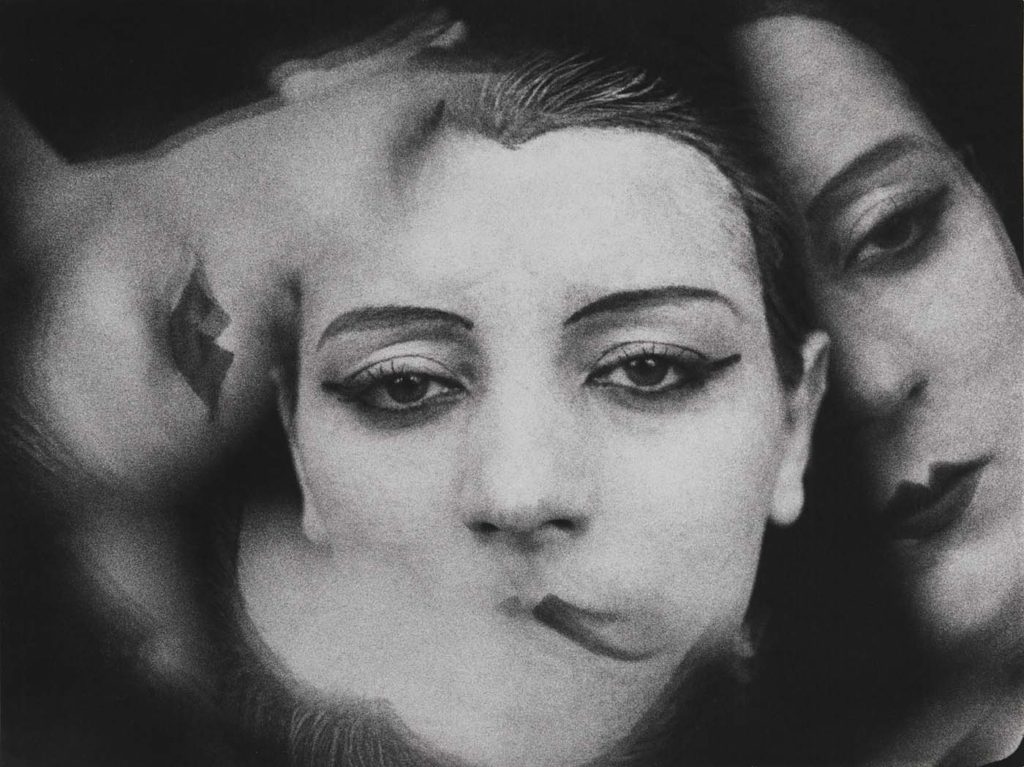
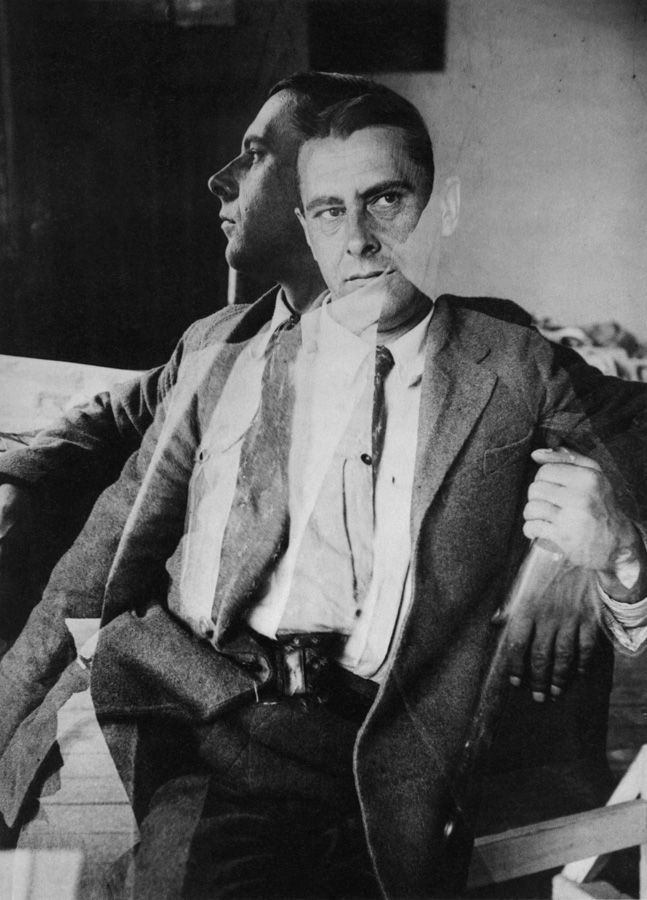
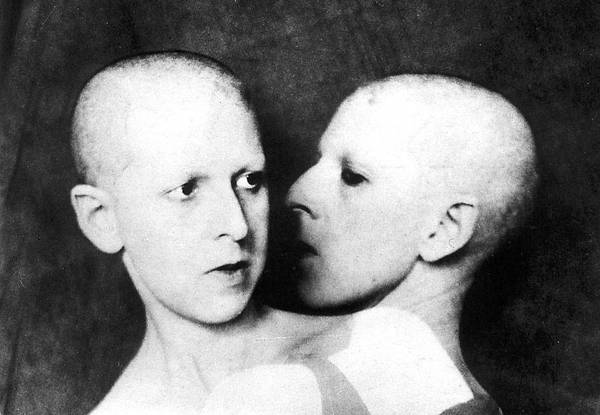
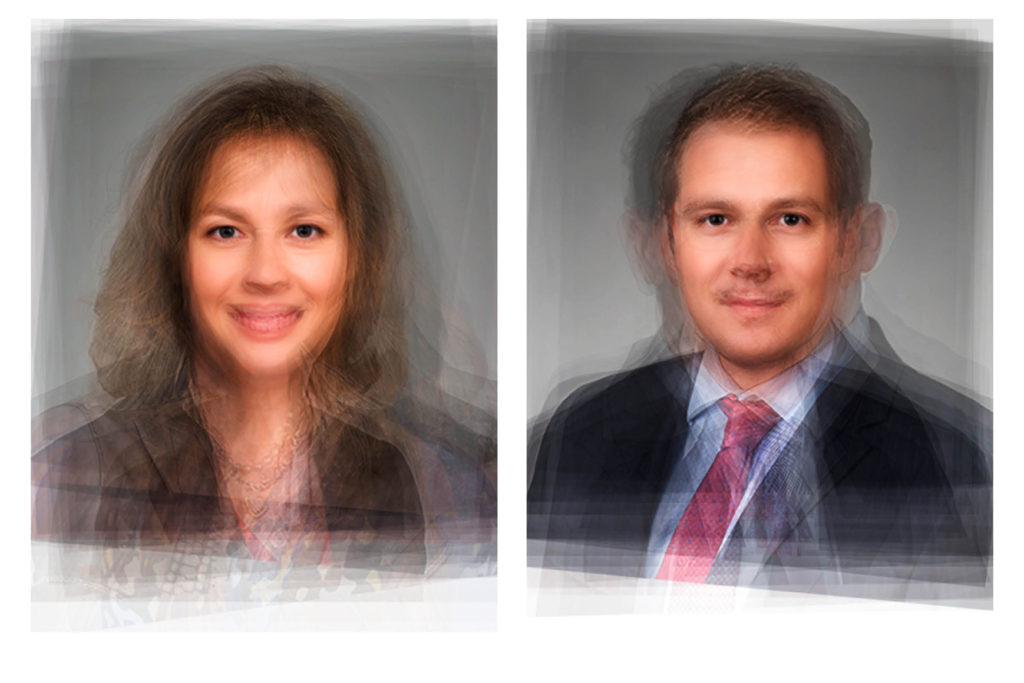

Photographic print
208 x 160 cm
Idris Khan’s Every… Bernd And Hilla Becher… series appropriates the Bechers’ imagery and compiles their collections into single super-images. In this piece, multiple images of American-style gabled houses are digitally layered and super-imposed giving the effect of an impressionistic drawing or blurred film still.
PHOTO-MONTAGE
Photomontage is the process and the result of making a composite photograph by cutting, gluing, rearranging and overlapping two or more photographs into a new image.
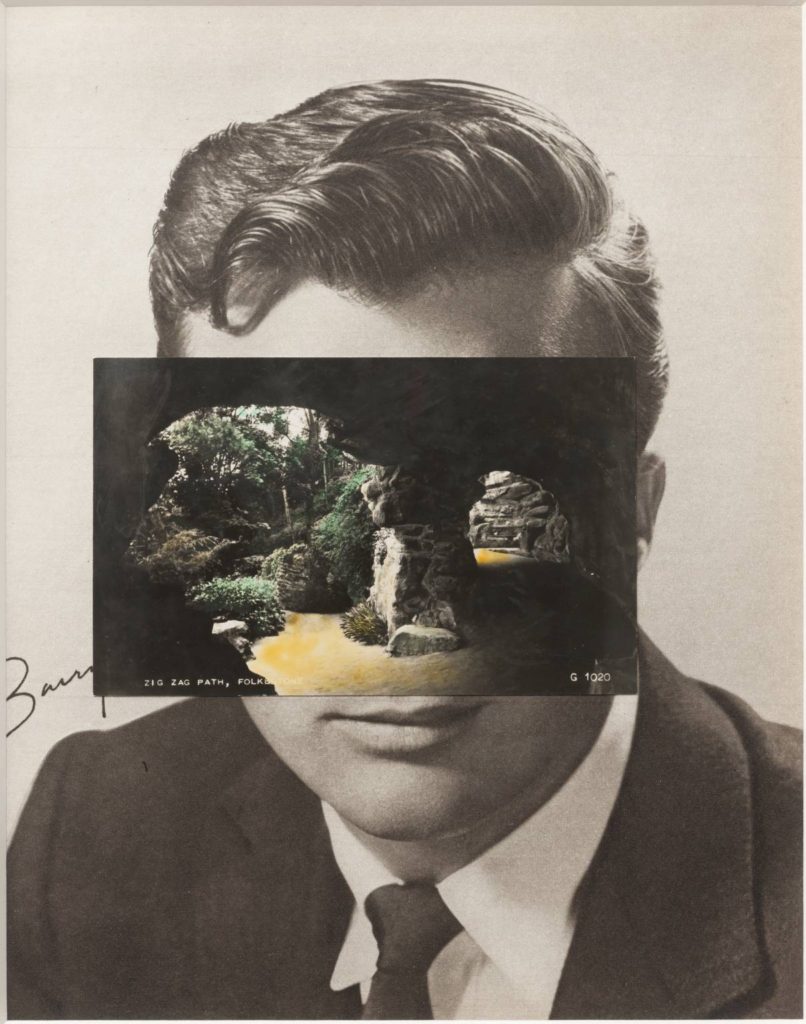
John Stezaker: Is a British artist who is fascinated by the lure of images. Taking classic movie stills, vintage postcards and book illustrations, Stezaker makes collages to give old images a new meaning. By adjusting, inverting and slicing separate pictures together to create unique new works of art, Stezaker explores the subversive force of found images. Stezaker’s famous Mask series fuses the profiles of glamorous sitters with caves, hamlets, or waterfalls, making for images of eerie beauty.

Pariwat Anantachina The L_st Album is a project that sprung from Pariwat’s love of exploring secondhand markets, ea markets, and even night markets; where he purchased fascinating mementos of unknown people. Albums that may have been lost and forgotten in houses, while moving, thereby being obtained by merchant scavengers to be sold in secondhand markets. These collections were revived by conveying about the relationships of people in the society which is known to be the smallest unit and is called “family“.
Photographs you must provide…
Task 1. The Object
Photograph a set of objects that belongs / belonged to a person who has a connection to Jersey. This could be someone who has a far-reaching family history in Jersey, or someone who has recently settled in the island.
Think about lighting and positioning of the object (s) and use white / plain backgrounds and an infinity curve if possible.
Photos required 50-100

Vanitas / still life
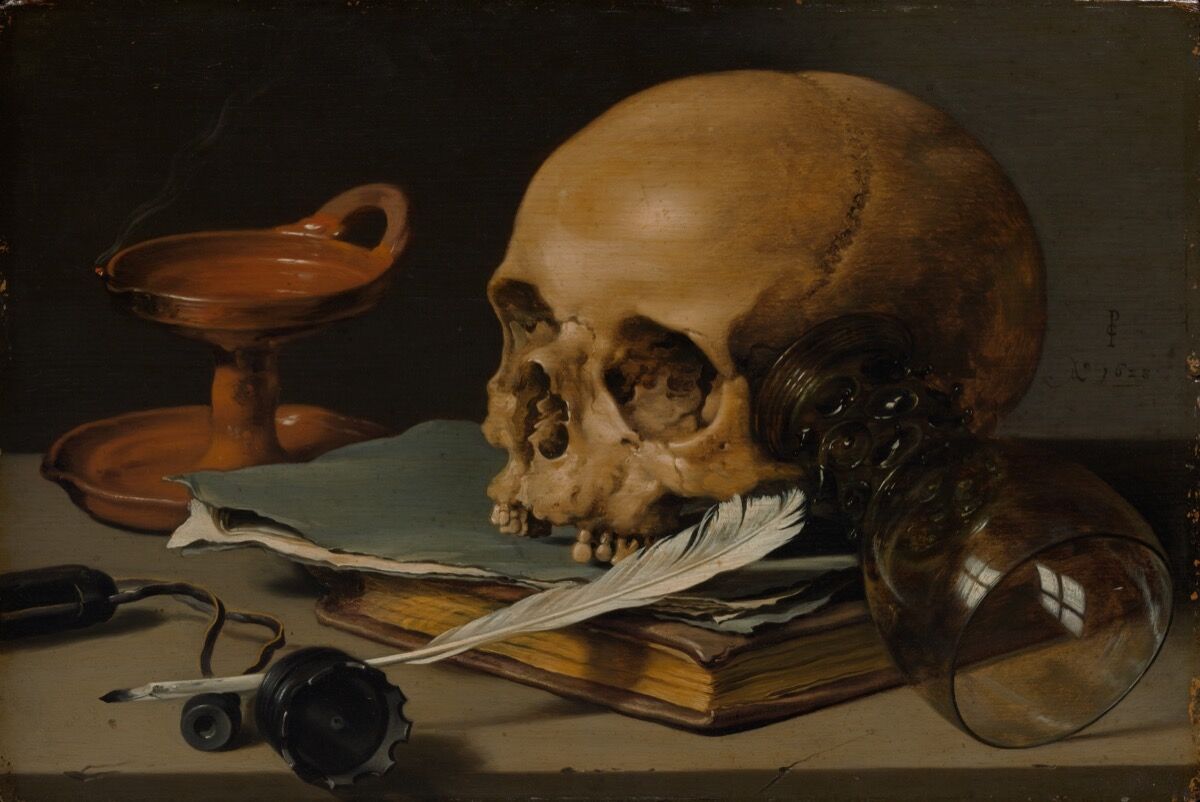
A vanitas is a symbolic work of art showing the transience of life, the futility of pleasure, and the certainty of death, often contrasting symbols of wealth and symbols of ephemerality and death.
The term originally comes from the opening lines of the Book of Ecclesiastes in the Bible: ‘Vanity of vanities, saith the Preacher, vanity of vanities, all is vanity.’
Vanitas are closely related to memento mori still lifes which are artworks that remind the viewer of the shortness and fragility of life (memento mori is a Latin phrase meaning ‘remember you must die’) and include symbols such as skulls and extinguished candles. However vanitas still-lifes also include other symbols such as musical instruments, wine and books to remind us explicitly of the vanity (in the sense of worthlessness) of worldly pleasures and goods.
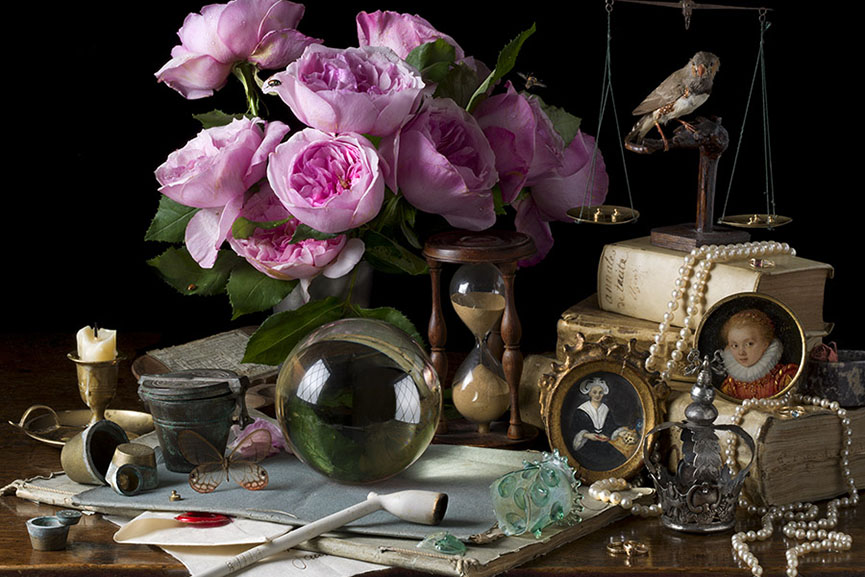
Inspired by the works of 17th century Old Master still life painters such as Giovanna Garzoni and Maria Sibylla Merian, American photographer Paulette Tavormina creates stunningly lit imagery of fruits and vegetables immersed in dark atmosphere
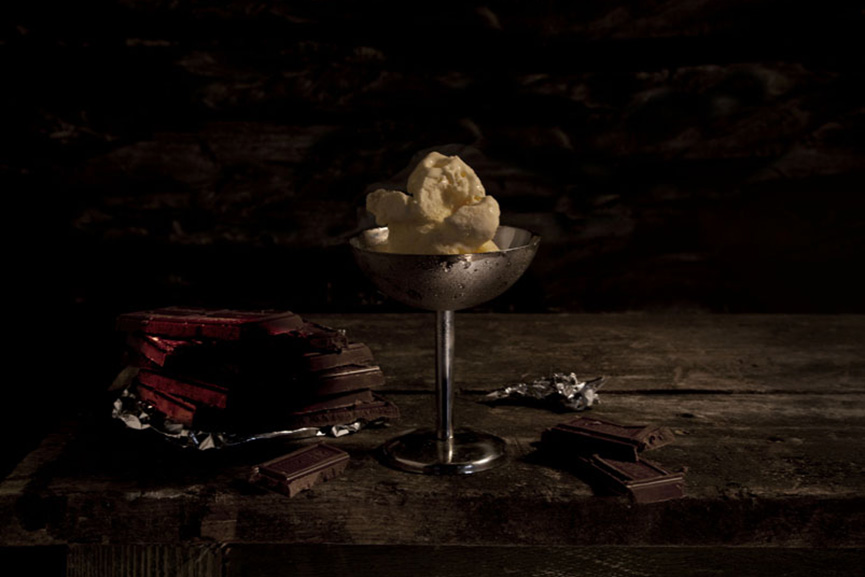
A perfect example of the old technique getting combined with modern-age ideas is Mat Collishaw’s Last Meal on Death Row series of works. Although they appear as meticulously arranged staged photography still lifes of food, each image is actually based on death row inmates’ last meals before they are executed. Apart from the eerie subject, the pictures deliver a strong drammatic effect through an excellent use of chiaroscuro.
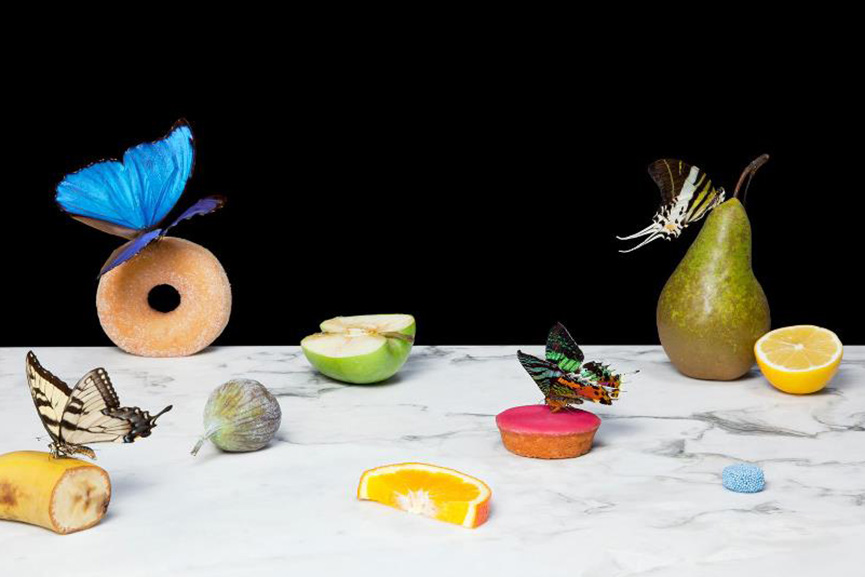
On a much more lighter, even pastel note, we have Dutch photographer Krista van der Niet, whose compositions often include fruits and vegetables mixed with mundane objects such as socks, cloths and aluminum foil, giving it all a contemporary feel. Her photos often carry a dose of satire as well, which references consumerism and popular culture through a clever employment of objects within a carefully composed scenery.
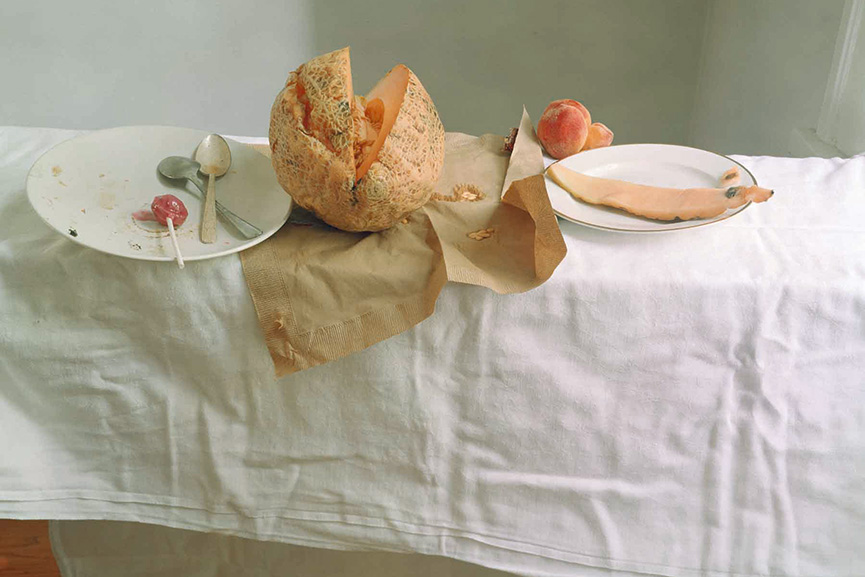
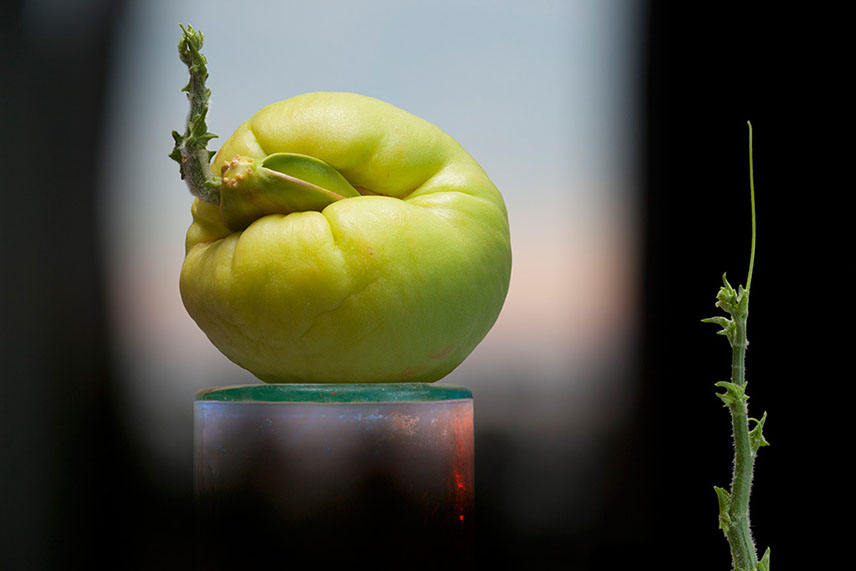
Experimenting with the endless possibilities of light, self taught photographer Olivia Parker makes ephemeral constructions. She started off as a painter, but soon turned to photography and quickly mastered the way to incorporate an extensive knowledge of art history and literature and reference the conflicts and celebrations of contemporary life in her work. Over the many years of her artistic career, her style remained fluid, yet consistent
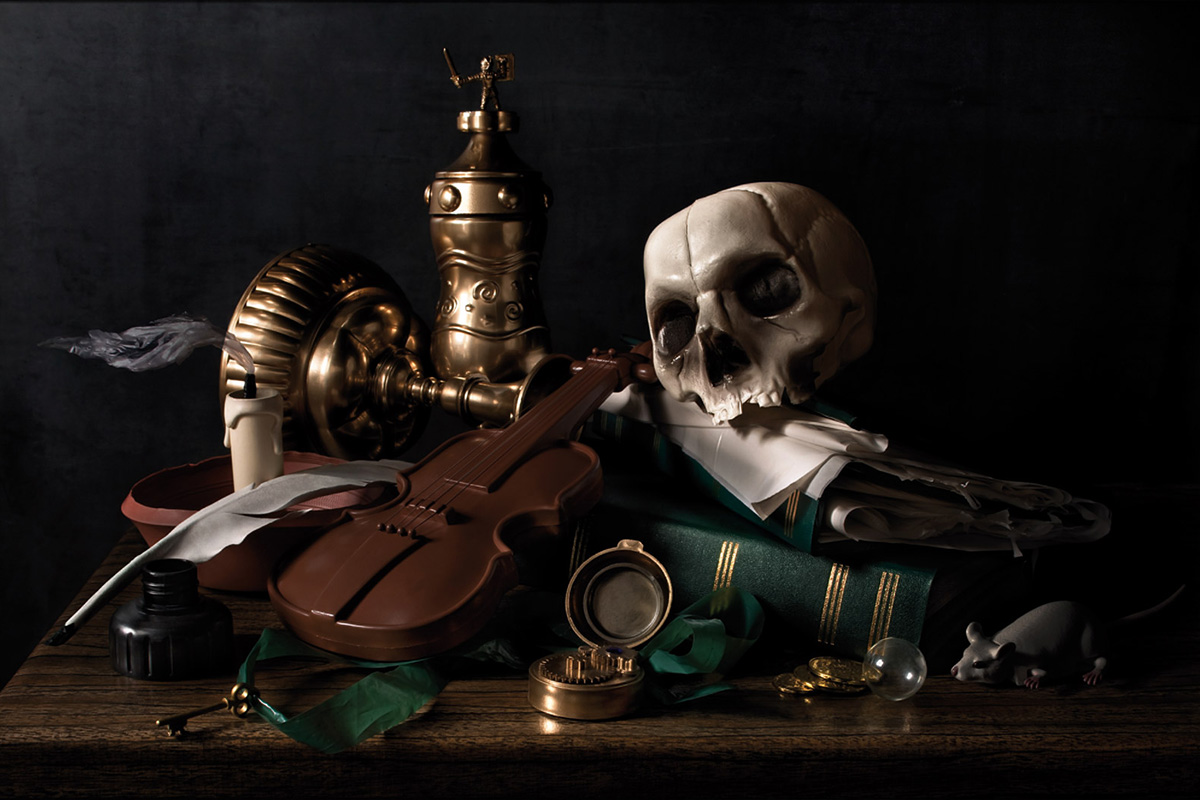
Think paintings by Pieter Claesz or Adriaen Coorte, only in plastic. That’s how one could describe the photographs of Richard Kuiper, whose objects are all made of this everlasting, widely used material, including water bottles, floral arrangements, even the feathers. The artist tries to draw our attention towards the excessive use of plastic in our everyday lives, with the hope we will be able to decrease it before it takes over completely.

Task 2. The Portrait
Create a set of portraits of the same person connected to Task 1 (The Object.)
The portraits can be headshots / close ups / half body / full length etc…see below for ideas and inspiration
Consider lighting and a clear, plain background eg a white wall
Photos required 50-100
THE DEADPAN AESTHETIC
According to sources the origins of the word “Deadpan” can be traced to 1927 when Vanity Fair Magazine compounded the words dead and pan, a slang word for a face, and used it as a noun. In 1928 the New York Times used it as adjective to describe the work of Buster Keaton.
It is less clear when it was first used to describe the style of photography associated with Edward Ruscha, Alec Soth, Thomas Ruff and many others. Charlotte Cotton devotes a complete chapter to Deadpan in The Photograph as Contemporary Art and much that has been written since references that essay.
In summary Deadpan photography is a cool, detached, and unemotional presentation and, when used in a series, usually follows a pre-defined set of compositional and lighting rules.
This style originated in Germany and is descended from Neue Sachlichkeit, New Objectivity, a German art movement of the 1920s that influenced the photographer August Sander who systematically documented the people of the Weimar Republic . Much later, in the 1970s, Bernd and Hilla Becher, known for their devotion to the principles of New Objectivity, began to influence a new generation of German artists at the Dusseldorf School of Photography (4). These young German photographers included Thomas Struth, Andreas Gursky, Candida Hofer and Thomas Ruff. The Bechers (4 & 5) are best remembered for their studies of the industrial landscape, where they systematically photographed large structures such as water towers, coal bunkers or pit heads to document a soon-to-disappear landscape in a formalistic manner as much akin to industrial archeology as art. The Bechers’ set of “rules” included clean, black and white pictures taken in a flat grey light with straight-on compositions that perfectly lent themselves to their presentation methodology of large prints containing a montage of nine or more similar objects to allow the study of types (typology) in the style of an entomologist.
If you want to learn more about the theoretical and philosophical basis for the deadpan aesthetic READ HERE.
Thomas Ruff wanted to mimick the setup for a having a set of passport images taken. Read an interview with him here recently published in the Financial Times
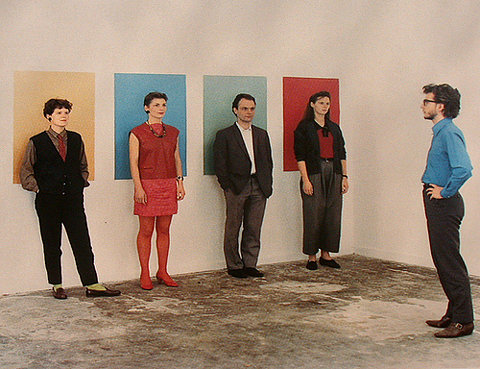
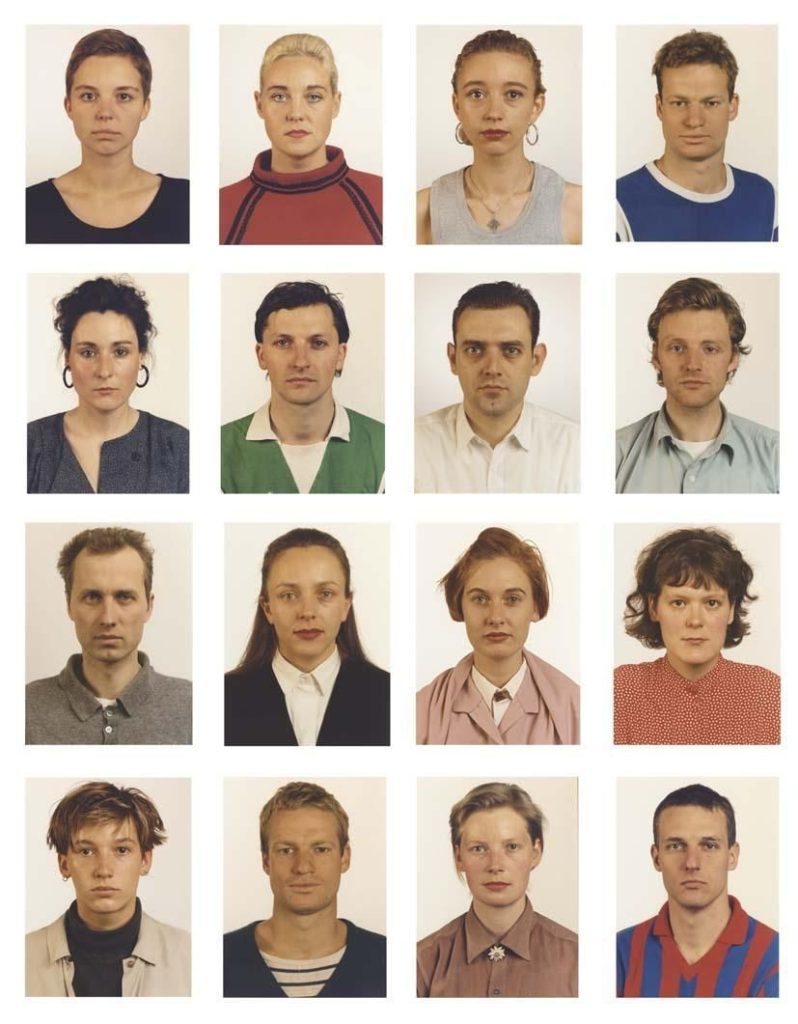
PASSPORT PHOTO
From the UK Government website
FACE:
- eyes must be open and clearly visible, with no flash reflections and no ‘red eye’
- facial expression must be neutral (neither frowning nor smiling), with the mouth closed
- photos must show both edges of the face clearly
- photos must show a full front view of face and shoulders, squared to the camera
- the face and shoulder image must be centred in the photo; the subject must not be looking over one shoulder (portrait style), or tilting their head to one side or backwards or forwards
- there must be no hair across the eyes
- hats or head coverings are not permitted except when worn for religious reasons and only if the full facial features are clearly visible
- photos with shadows on the face are unacceptable
- photos must reflect/represent natural skin tone
BACKGROUND:
Photos must have a background which:
- has no shadows
- has uniform lighting, with no shadows or flash reflection on the face and head
- shows a plain, uniform, light grey or cream background (5% to 10% grey is recommended)
This influenced by the work of earlier German photographers linked to the New Objectivity movement of the 1920s such as August Sander, Karl Blossfeldt and Albert-Renger-Patzsch.
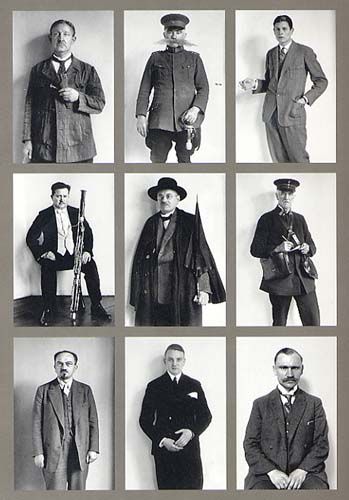

BRUCE GILDEN: FACE: Bruce Gilden is renowned for his confrontational style and getting up close to his subject. Between 2012-14 Gilden travelled in America, Great Britain, and Colombia and created a series called FACE. Read a review here in the Guardian newspaper and another on Lensculture.
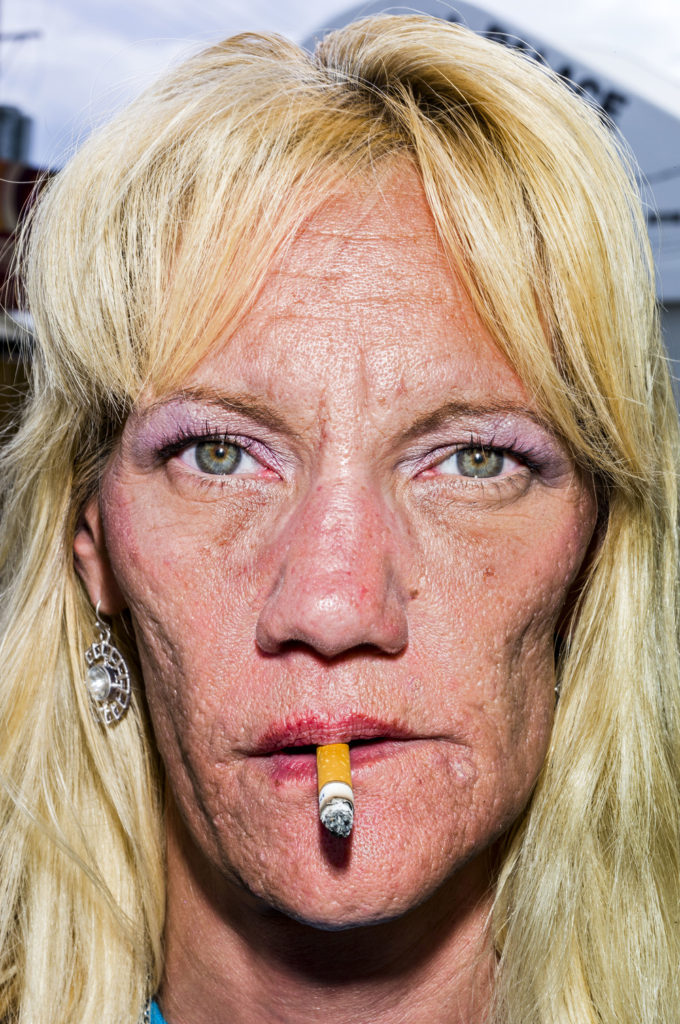
UP CLOSE
In addition to focusing on details of the face try and isolate body parts, gestures, clothing and physical features, such as hands, elbows, shoulders, neck, torso, hip, knees, feet. Your understanding of abstraction in photography; focusing on shapes, colours, light and shadows, textures and repetition is crucial here.
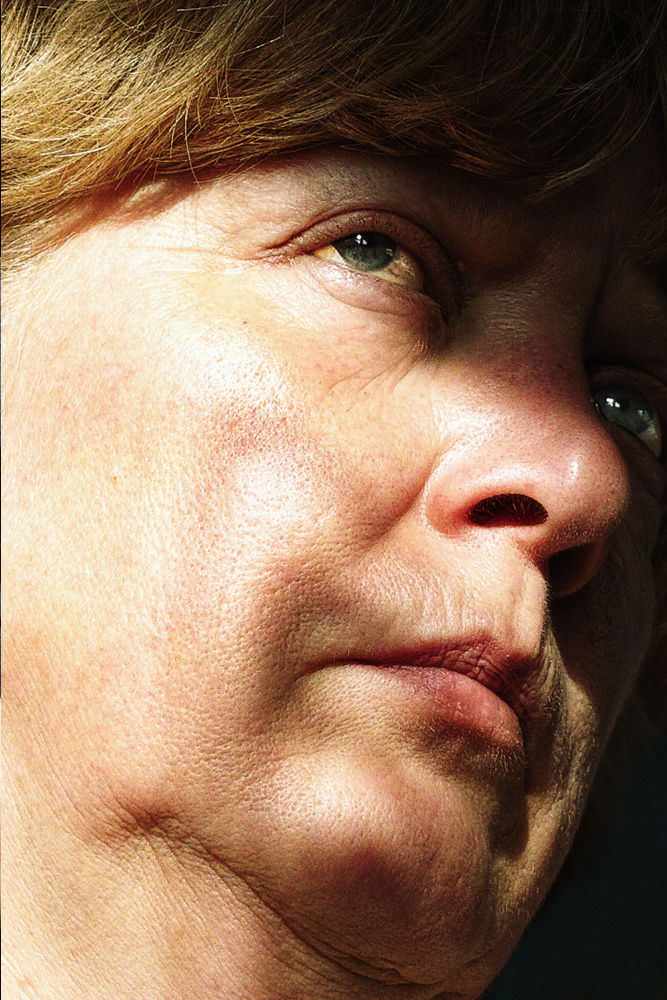
Satoshi Fujiwara: Code Unknown: In Michael Haneke’s 2000 film Code Unknown, there is a scene in which the protagonist’s lover, a photographer, secretly snaps pictures of passengers sitting across from him on the train.
When we look at another person, either directly or through another medium, we interpret a wide range of information based on outward appearance (face, physique, clothes and accessories, and movements)—in other words, various codes. By regulating and altering these codes in various ways, I set out to obscure the individuality and specificity of the subjects in the pictures in my series.—Satoshi Fujiwara
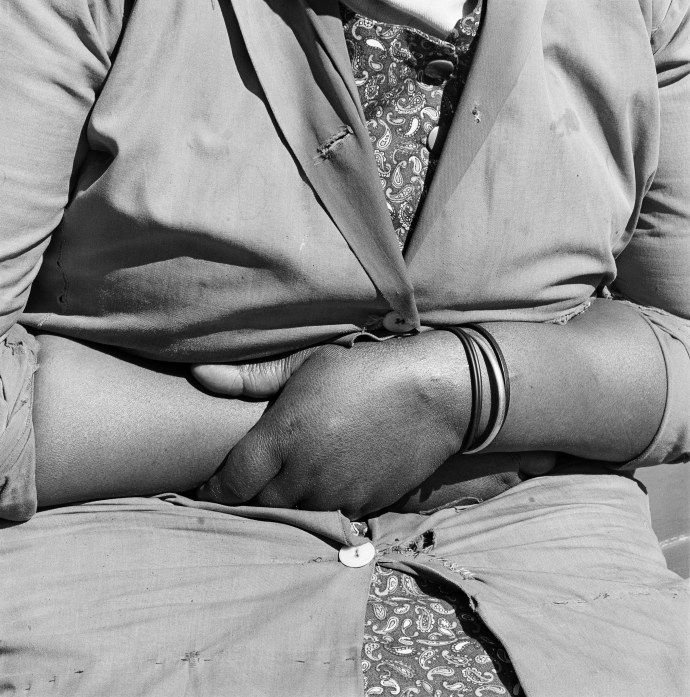
David Goldblatt: Particulars: Following a series of portraits of his compatriots made in the early 1970s, photographer David Goldblatt, for a very short and intense period of time, naturally turned to focusing on peoples’ particulars and individual body languages…
In this series we see hands resting on laps, crossed legs, the curved backs of sleepers on a lawn at midday, their fingers and feet relaxed, pausing from their usual occupations.
Task 3. The Place
Rule : The Place(s) must be connected to the person / people in Task 2. The locations could have a significance, or evoke a memory…

Robert Adams
You must include images of key locations in Jersey that have a historic significance to the person you have focused on. You must photograph the location(s). The Locations can be inside or outside. Try to avoid obvious / iconic locations (no sunsets over Corbiere please!)
-(the-lovers-(promenade)).jpg)


Aim for locations that have a personal and unique reasoning to the personalities you are focusing on…or meaningful historic locations such as…
Dolmen / German bunkers and fortifications / traditional Jersey buildings etc
Channel Island Occupation Society
Remember : landscapes and locations have memory, historical, cultural and social significance
Consider lighting and composition, camera settings and exposure levels.
Photos required 50-100
Your powerpoint must include…
- Research photo-montage and a range of artists from the selection provided
- Analyse his/her work, style, technique, meaning – show some knowledge and understanding
- Respond – produce at least 3 different shoots that show development of your ideas
- Edit – make a first selection and cut down the three shoots to the best ten images, and justify your selection
- Experiment – work on cropping, adjustments of brightness/ contrast/ colour correction and show further Photoshop / editing techniques if possible
- Evaluate – describe process of experimentation and reflect on learning
- Present – put all work together in a digital format such as Powerpoint
- Select your most successful outcomes, print out as an A4 image and explain why you have chosen it in your final evaluation (at least 200-300 words.)
How to proceed:
Research a relevant artist reference explain why you have chosen that particular photographer. What do his / her photographs say to you? Look at composition and its visual elements e.g. line, form, shape, colour, tone, contrast, texture, depth, balance, space, perspective, viewpoint, foreground/ mid-ground/ background, rule of thirds. Look at the use of lighting e.g. natural lighting; sunlight, overcast, soft, harsh, directional, contrast and artificial lighting: studio, flash, spotlight, side-light, backlight, reflected light, shadows, chiaroscuro (light / darkness).
Use photographic language as above in your annotation and consider the artistic merits :
Technical , Visual , Conceptual and Contextual elements…
- Write a short introduction about the work of your chosen photographer and the nature of their work
- Issues to consider:
- His / her attitude to photography and the advantages / disadvantages of the camera as a way of “seeing”
- Are we looking at fact or fiction (or a hybrid of both?)
- The ways in which your chosen photographer explored the formal elements in his / her work e.g. form, light, rhythm, line, texture, repetition etc.
Planning: Once you have spent time evaluating the work of your chosen photographer, plan a shoot using the same techniques and mindset.
You must: Produce a mind map showing your thought process and with breadth of thinking, and a mood board (collage of images) to illustrate the look and feel of your project.
You should: include your thoughts, how are you going to proceed with the project? What are your inspirations? Your doubts? Your worries? How will you start? Consider as many experiments as you can.
Recording: After planning your idea, gather together what you need. When you take pictures try and think about everything that you see in the frame – what’s in the foreground, mid-ground, background. To achieve this you must think about composing your picture (use your zoom lens and/or distancing yourself from subject/object), focussing (sharp, soft focus), use creative exposure tools on camera like fast/slow shutter speed to either freeze or blur a sense of movement, different aperture settings to control the area of focus and sharpness in your picture. E.g. a high aperture setting like f5.6 will make the background soft and out of focus whereas an aperture of f16 will make everything in the picture sharp from foreground to background. Also by zooming in or using a telephoto lens you can throw the background out of focus, or conversely if using a wide-angle everything in the frame will be in focus. Crop your images carefully.
You must: Produce the contact prints from at least three shoots, each dated with your selections highlighted.
Editing: Editing is one of the most important aspects of photographic practice so be critical and selective when you choose your final selection of 5 images and then your best photograph. Think about sequence and relation between images – does your series of images convey a sense of narrative (story) or are they repetitious? Sometimes less is more!
You Must: Gather your images and select your final selection of 5-10 images, describe each of the images, artistically and share your thoughts on what why you took and then selected the image.
You should: Show your ability to correct the images using image manipulation software, such as Adobe Photoshop, consider the cropping, adjust levels, contrast, colour correction, B/W and balance of the image.
You could: Use Adobe Photoshop to enhance your creativity and expand on the possibilities that photography gives you, include screen grabs to illustrate the techniques you have used.
Presentation: Think about how you present your work in terms of layout, scale, colour and perspective. A Powerpoint presentation is ideal
The presentation of your photographs is just as important as your photographic images themselves. Consistency of layout throughout is paramount and try to make your work personal.
You must: Gather all of your work and present it in a logical manner
A grid format could work well for this exercise…
You should: Produce an individual and comprehensive response to both your chosen artists and the inspirations that the artist has given you.
You could: Design within Adobe Photoshop or similar package, a theme to enhance the imagery and clarify the message of your response.
Evaluation: Reflect, contrast and compare the images and idea have lead to how you made the photos, development of ideas and what you were trying to achieve and communicate. This can be done throughout your layout as annotation or at the end as part of your final evaluation. Finally, choose your favourite image and present this separately from your series of images.
Make sure you bring with you: all of your work including your best A4 printed images / montages for your first photography lesson in September 2022
Remember to follow the 10 Step Process to tackle all Assessment Objectives thoroughly :
- Mood-board, definition and introduction (AO1)
- Mind-map of ideas (AO1)
- Artist References / Case Studies (must include image analysis) (AO1)
- Photo-shoot Action Plan (AO3)
- Multiple Photoshoots + contact sheets (AO3)
- Image Selection, sub selection (AO2)
- Image Editing/ manipulation / experimentation (AO2)
- Presentation of final outcomes (AO4)
- Compare and contrast your work to your artist reference(AO1)
- Evaluation and Critique (AO1+AO4)
Good luck and get creative!
Contact : j.cole@hautlieu.sch.je
What equipment you need to start the course…
- SD Card
- USB / pendrive
- Card-reader / comverter
- Camera (optional as we have loan cameras)
We also provide an Adobe Licence for you to install Photoshop etc
INDUCTION DAY EXERCISES
Photography’s function(s)
Photography as an art-form
Photography as a science
The difference between the study of photography and the practice of photography
Henri Cartier-Bresson once said…”Your first 10,000 photographs are your worst”
What do you think Cartier-Bresson meant by this…? Discuss
Demonstrating a critical and contextual understanding of photography can be tricky, especially if the subject is relatively new to you in Year 12. The following activities have been designed to encourage you to reflect on what you know already about photography. Hopefully, some of the prompts will encourage you to further develop your understanding of photography through additional pondering and research.
In small groups, discuss the following questions. One person in the group should be responsible for making notes capturing the main ideas of the discussion:
- Why do people take/make photographs?
- Why is photography important?
- What skills do you need to be a good photographer?
- How many different kinds of photography can you think of?
- How does photography help us see the world?
- Can photographic images be trusted?
- What are the similarities and differences between photography and other types of visual art?
- When would it not be OK to take a photograph?
- How do you know when you’ve made a good photograph?
- Are photographers also artists?
- Where is the best place to see photographs?
- What kind of photography interests you most?
- What confuses or frustrates you about photography?
Watch this short film in which the photographer Henry Wessel discusses his practice. Make some brief notes. What does he help us to understand about photography?
Now compare with this example…

https://photoworks.org.uk/watch-artist-film-with-silvia-rosi/
